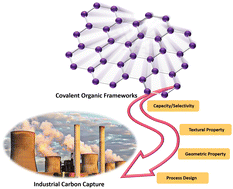Covalent organic frameworks for CO2 capture: from laboratory curiosity to industry implementation
Abstract
CO2 concentration in the atmosphere has increased by about 40% since the 1960s. Among various technologies available for carbon capture, adsorption and membrane processes have been receiving tremendous attention due to their potential to capture CO2 at low costs. The kernel for such processes is the sorbent and membrane materials, and tremendous progress has been made in designing and fabricating novel porous materials for carbon capture. Covalent organic frameworks (COFs), a class of porous crystalline materials, are promising sorbents for CO2 capture due to their high surface area, low density, controllable pore size and structure, and preferable stabilities. However, the absence of synergistic developments between materials and engineering processes hinders achieving the qualitative leap for net-zero emissions. Considering the lack of a timely review on the combination of state-of-the-art COFs and engineering processes, in this Tutorial Review, we emphasize the developments of COFs for meeting the challenges of carbon capture and disclose the strategies of fabricating COFs for realizing industrial implementation. Moreover, this review presents a detailed and basic description of the engineering processes and industrial status of carbon capture. It highlights the importance of machine learning in integrating simulations of molecular and engineering levels. We aim to stimulate both academia and industry communities for joined efforts in bringing COFs to practical carbon capture.



 Please wait while we load your content...
Please wait while we load your content...